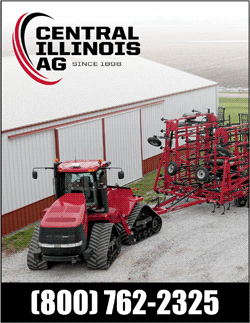 While there has been a slight improvement since fall 2012, drought
conditions are still serious, with 67 percent of the states
remaining at the most intense measurement of D4, exceptional
drought. The primary area covers most of the central portion of the
country, beginning west of Illinois. While there has been a slight improvement since fall 2012, drought
conditions are still serious, with 67 percent of the states
remaining at the most intense measurement of D4, exceptional
drought. The primary area covers most of the central portion of the
country, beginning west of Illinois.
As of Feb. 21, portions of the western edge of Illinois and upper
northwest Illinois were still in drought, but improving.
In a three-month outlook starting Feb. 21, while there may be
slight recovery, drought is expected to persist and possibly worsen
over much of the most serious drought areas in the U.S.
March, April and May are forecast to bring above-normal
temperatures for most of the nation, including Illinois, with
above-normal rainfall anticipated for the Great Lakes region and
surrounding states.

For those who prefer the old ways, or maybe some entertainment
value with their forecast, the Farmers' Almanac is another way to
get your forecast. Printed since 1818, the publication features
weather, but is also chock-full of other useful information, humor,
advice, trivia and helpful tips. (http://www.farmersalmanac.com/)
A quick look at the Farmers' Almanac two-month forecast starting
March 4 suggests the same precipitation as NOAA is forecasting: a
wet period. Temperatures are not provided.
Released annually in September, the Farmers' Almanac offers 16
months of weather predictions made as far out as two years in
advance. The publishers explain that they use a "top secret
mathematical and astronomical formula, that relies on sunspot
activity, tidal action, planetary position and many other factors."
Their readers and purported independent studies of their
forecasts claim 80-85 percent accuracy.
Here's a look at an entirely different almanac, The Old Farmer's,
started in 1792. It's older. Old Farmer's Almanac indicated
agreement with NOAA in warmer temps: 5 degrees above average in
March and 3 degrees above in April.

[to top of second column] |

The Old Farmer's Almanac forecasts that March and April
precipitation would finish an inch below average rainfall. If that
actually suggests that it would be drier, then it would be opposite
of the NOAA and the Farmers' Almanac prediction of wet. But wait,
that would not encompass the same time frame. May could reverse the
trend and end the three-month cycle wet also. We'll just have to
wait and see.
Here is the Old Farmer's Almanac 2013 Long-Range Weather Forecast
for Springfield, Illinois:
(Copy)
Annual Weather
Summary: November 2012 to October 2013
Winter will be
colder than normal in the east, with above-normal temperatures in
the west. The coldest periods will be from late December through
early January and in mid-January and early and mid-February.
Precipitation and snowfall will generally be below normal, with the
snowiest periods in early to mid-November, early January, and early
March.
April and May will
be warmer and drier than normal, with an especially warm first half
of April.
Summer temperatures
and rainfall will be near normal, on average, despite a tropical
rainstorm threat in mid-June. The hottest periods will be in early
to mid-July, late July, and mid-August.
September and
October will be warmer and drier than normal.
--From
http://www.almanac.com/weather/
longrange/IL/Springfield

See The Old Farmer's Almanac long-range weather forecasts for
major cities in Illinois:
http://www.almanac.com/weather/longrange/IL
[By JAN YOUNGQUIST]
|
Spring 2013
Logan County Farm Outlook
|
|